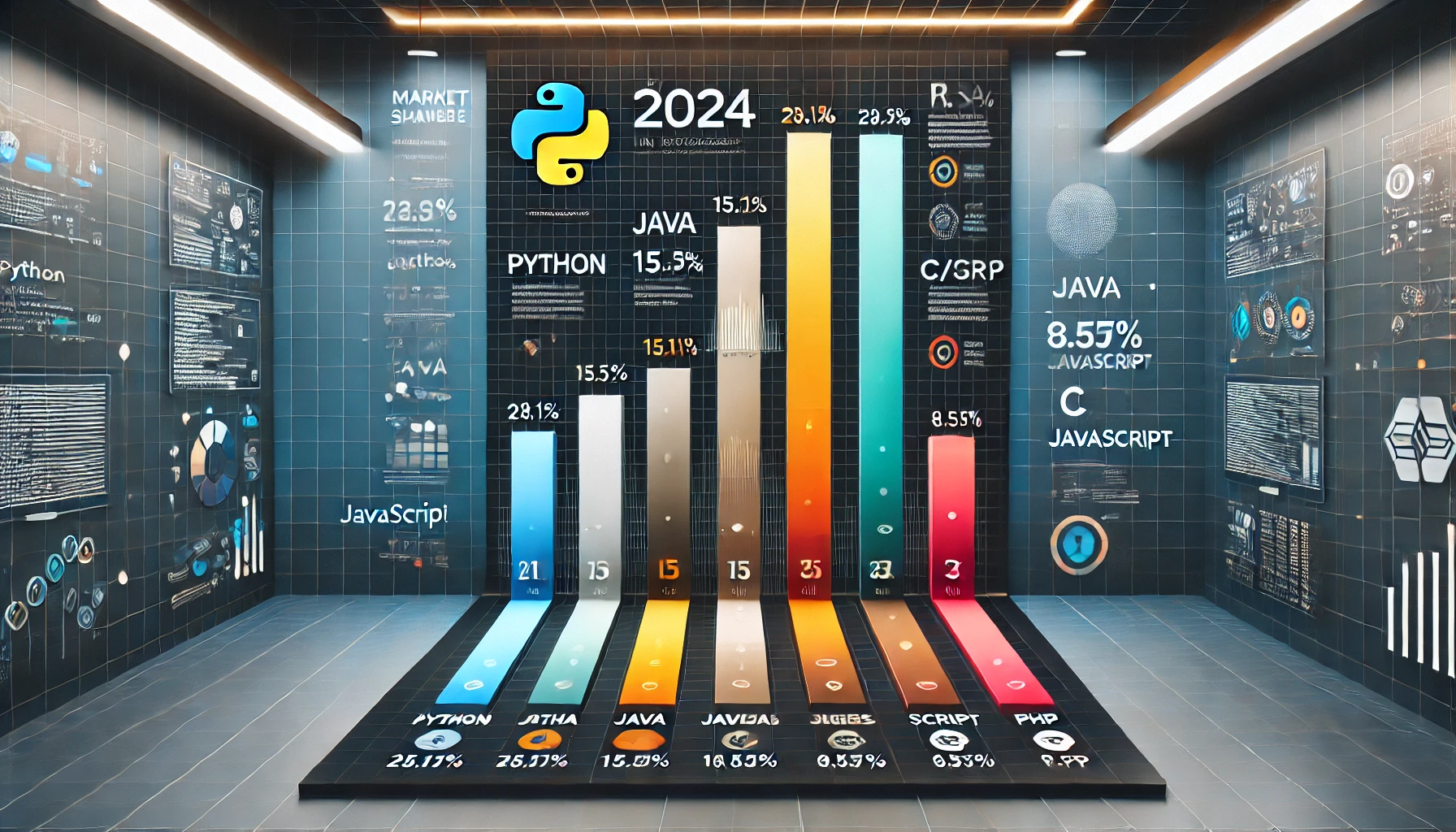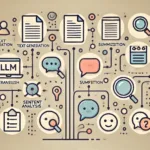Introduction
In the fast-evolving world of technology, programming languages act as the backbone of innovation, enabling developers to build the applications and software solutions that power modern industries. Knowing which languages are gaining traction or losing relevance is crucial for staying competitive, whether you’re a software engineer, a business decision-maker, or an educator shaping the next generation of tech talent.
As of 2024, Python has emerged as the most widely used programming language, holding a commanding market share of 28.11% according to the PYPL (Popularity of Programming Language) index. This continues a trend that has seen Python’s adoption steadily increase due to its versatility, simplicity, and strong community support. Understanding why Python has risen to this dominant position and examining the broader landscape of programming languages provides valuable insights into current and future software development trends.
Overview of Programming Language Trends in 2024
Introduction to PYPL Index
The PYPL (Popularity of Programming Language) index is one of the key indicators used to gauge the global popularity of programming languages. It analyzes how often language tutorials are searched for on Google, reflecting the demand for these languages among developers and students. By tracking these searches, the index provides an accurate snapshot of which programming languages are being actively learned and used.
The PYPL index’s relevance extends beyond just gauging popularity; it serves as a pulse on the shifting dynamics of the programming landscape. A higher ranking indicates not only widespread usage but also community growth and industry adoption, making it a valuable resource for assessing language trends and their practical applications.
Explanation of Market Share Data
The market share data represented in the PYPL index shows the percentage of searches attributed to each programming language. This metric gives insight into how developer preferences are evolving, which languages are gaining or losing mindshare, and where industry focus might be shifting. For 2024, Python’s market share of 28.11%—an increase of 0.6% from the previous year—demonstrates its continued dominance and versatility across fields like web development, data science, and artificial intelligence.
General Trend Observations
The programming landscape in 2024 reveals both stability and subtle shifts among the top languages. Python, Java, and JavaScript maintain their positions at the top, with Python continuing its ascent. Java, however, has seen a slight decline (-0.1%), signaling that while it remains a stalwart for enterprise applications, newer languages are capturing the interest of the developer community.
R, a language primarily used for statistical analysis and data visualization, has shown notable growth (+0.7%), indicating increased interest in data-centric fields. Conversely, PHP has seen a drop in popularity (-0.6%), suggesting a waning preference for traditional web development stacks in favor of newer technologies like JavaScript frameworks and Python-based web solutions.
These shifts, though incremental, are significant in predicting the future trajectory of programming languages. They reveal which technologies are becoming more critical and which ones may be declining, guiding developers and businesses in making informed decisions about which languages to invest in for future projects.
Analysis of the Most Used Programming Language – Python
Python’s Dominance and Market Share
As of 2024, Python stands at the pinnacle of programming language popularity with a commanding market share of 28.11%, according to the PYPL index. This marks a slight but consistent increase in its adoption, rising by 0.6% compared to the previous year. Python’s sustained growth in market share is a testament to its adaptability and widespread acceptance across various sectors. Over the past decade, Python has gradually climbed the ranks, surpassing stalwarts like Java and C/C++ to claim its position as the most dominant language.
Historically, Python’s upward trajectory can be attributed to its dual appeal to both novice programmers and seasoned professionals. While other languages like Java and C maintain their niche specialties, Python has become a general-purpose powerhouse that’s as accessible for beginners learning their first lines of code as it is for experts deploying complex machine learning models. Its ability to remain relevant and valuable in multiple domains has solidified its place at the top of the programming hierarchy.

Why is Python So Popular?
Python’s enduring popularity in 2024 can be explained by three core factors: versatility, ease of learning, and a robust ecosystem of libraries and community support.
- Versatility:
One of Python’s standout features is its versatility. It is widely used across a range of fields, from web development and software engineering to data science, artificial intelligence (AI), machine learning, and scientific computing. This multi-purpose nature allows Python to serve as a one-stop solution for diverse programming needs, making it a go-to choice for professionals working on varied projects. For instance, web developers use frameworks like Django and Flask to build scalable web applications, while data scientists leverage libraries such as Pandas and NumPy for data manipulation and analysis. Python’s presence in such a wide array of fields means it often becomes a default language for teams looking to maintain a cohesive stack. - Ease of Learning:
Python’s syntax is designed to be intuitive and readable, making it one of the most beginner-friendly languages. The simplicity of its code structure allows new programmers to grasp fundamental concepts without getting overwhelmed by complex syntax rules. This ease of learning has made Python the language of choice in educational settings and coding boot camps, where it’s often the first language introduced to students. For businesses, this means that onboarding new talent or reskilling employees in Python is relatively straightforward, reducing the learning curve and accelerating productivity. - Extensive Libraries and Community Support:
A rich ecosystem of libraries and frameworks is another factor driving Python’s popularity. Whether it’s TensorFlow and PyTorch for machine learning, SciPy for scientific computing, or Matplotlib and Seaborn for data visualization, Python has a library for almost any use case. This expansive toolkit allows developers to build solutions rapidly without reinventing the wheel. Moreover, Python’s strong community support ensures that developers can find extensive documentation, tutorials, and forums to troubleshoot issues or learn new techniques, fostering a collaborative environment that continually enhances the language.
Industries Driving Python’s Growth
Python’s rise to the top is not only due to its inherent features but also because of its widespread adoption in key industries that are defining the future of technology.
- Artificial Intelligence and Machine Learning:
Python is the language of choice for AI and machine learning, thanks to its powerful libraries like TensorFlow, Keras, and Scikit-Learn, which simplify complex algorithms and data manipulation. Companies ranging from tech giants like Google to innovative startups are leveraging Python to develop intelligent systems, ranging from chatbots to predictive models. - Scientific Computing:
Researchers and scientists favor Python for its ability to handle complex computations and data analysis tasks. Libraries such as SciPy, SymPy, and Biopython offer tools tailored for fields like physics, chemistry, and bioinformatics, making Python indispensable in academic and research settings. - Data Science and Analytics:
Python has become synonymous with data science. Libraries like Pandas for data manipulation, NumPy for numerical operations, and Matplotlib for data visualization make it a powerful tool for processing and visualizing large datasets. Python’s integration with Jupyter notebooks further enhances its appeal by providing an interactive environment where analysts can document their work, share results, and collaborate seamlessly. - Web Development:
Although newer technologies are emerging, Python continues to be a strong contender in web development, particularly for backend development. Frameworks such as Django and Flask are popular for building secure, scalable web applications. Python’s straightforward syntax and strong support for RESTful services make it a preferred choice for developing APIs and web services.

In 2024, these industries are driving Python’s growth and solidifying its status as the most versatile and widely used programming language. As technology continues to evolve, Python’s adaptability ensures that it will remain a central tool for solving both current and future challenges in the tech world.
Other Prominent Programming Languages in 2024
Java: The Enterprise Powerhouse
With a market share of 15.52% in 2024, Java maintains its reputation as a reliable and robust language, although it has experienced a slight dip of 0.1% compared to previous years. Despite this minor decline, Java remains deeply entrenched in enterprise-level applications and large-scale systems, where stability, security, and performance are paramount. Its strong type system, extensive libraries, and long-standing presence make it a staple in industries such as finance, healthcare, and telecommunications.
Java’s continued relevance can also be attributed to its integral role in Android development. As the primary language used to build Android applications, Java is indispensable for mobile developers targeting the Android ecosystem. Although Kotlin has gained ground as a preferred language for modern Android apps, Java’s extensive documentation and backward compatibility ensure its sustained use across legacy systems and long-term projects.
JavaScript: The Web Development Staple
JavaScript commands a market share of 8.57% in 2024, securing its position as the go-to language for web development. Known for its flexibility and adaptability, JavaScript powers interactive and dynamic web content, making it an essential tool for front-end developers building user interfaces. Its unique ability to run on both the client and server sides has enabled it to become a core technology for full-stack development, alongside HTML and CSS.
JavaScript’s dominance in front-end frameworks such as React, Angular, and Vue.js, combined with its utility on the server side through Node.js, underscores its versatility. As web applications continue to evolve towards more complex, real-time interactions, JavaScript remains the backbone of modern web experiences, providing the tools to create responsive and interactive sites. Its massive developer community and broad ecosystem make it a language that remains both in-demand and future-proof for web-centric development.
C/C++: System Programming Backbone
With a market share of 6.92% and a positive growth trend of +0.1% in 2024, C/C++ remains a foundational technology for system programming and performance-critical applications. The efficiency and control offered by these languages make them ideal for developing operating systems, embedded systems, and high-performance applications, such as video games and real-time simulations.
C++’s object-oriented features, combined with C’s low-level memory management capabilities, provide developers with granular control over hardware and system resources. This makes C/C++ the go-to choice for scenarios where performance optimization is crucial. Despite newer languages attempting to capture some of this space, C/C++’s established role in system-level programming ensures it remains highly relevant in areas where speed and precision are non-negotiable.
R: Growth in Data Science and Analytics
R holds a market share of 4.75% in 2024, reflecting a notable increase of +0.7% compared to the previous year. While traditionally used in academic and research environments, R’s growing adoption in the business world can be linked to its specialization in statistical analysis and data visualization. With an extensive range of packages like ggplot2, dplyr, and Shiny, R provides a comprehensive suite of tools for statisticians and data analysts to create complex models and compelling visualizations.
R is particularly favored in industries that require deep data insights, such as finance, healthcare, and academia. Its ability to handle large datasets, perform sophisticated statistical tests, and present findings in an accessible manner has cemented its status as a top choice for data-centric projects. This focus on data science has allowed R to carve out a niche, even as Python also makes inroads in the analytics space.
Other Languages to Watch
Several other programming languages continue to play significant roles in 2024, each catering to specific use cases and development environments:
- Swift: With a market share of 2.75% and a positive trend (+0.5%), Swift is the language of choice for iOS and macOS application development. Its modern syntax and performance optimizations make it a popular option for developers building Apple ecosystem apps.
- C#: Holding a 6.73% market share, C# remains crucial for game development (particularly with Unity) and enterprise solutions within the Microsoft stack. Despite a minor decline (-0.1%), it retains a strong following due to its robustness and integration with .NET.
- PHP: At 4.57% market share and a downward trend (-0.6%), PHP’s usage has declined as newer server-side technologies emerge. However, it still powers a substantial portion of the web, including content management systems like WordPress, which ensures its continued, albeit reduced, presence.
- TypeScript: With a stable 2.78% share and no significant trend changes, TypeScript builds on JavaScript’s strengths, offering better type safety and scalability for large-scale applications. Its adoption by popular frameworks like Angular and the growing trend toward type-safe JavaScript ensure TypeScript’s place in modern web development.
- Objective-C: While Objective-C has a smaller share (2.37%) and minimal growth (+0.1%), it remains relevant for maintaining legacy iOS applications. With Swift gradually taking over new iOS development, Objective-C’s role has become more specialized, supporting older codebases.
Emerging Contenders
- Go: Known for its simplicity and performance, Go is increasingly favored for cloud-native development and concurrent applications. Its clean syntax and strong support for multi-threading make it ideal for backend services and microservices architecture.
- Kotlin: With strong backing from Google, Kotlin is rapidly gaining traction as the preferred language for Android development, thanks to its modern syntax and enhanced safety features. It is gradually replacing Java in many new Android projects, signaling a shift in the mobile development space.
As new programming languages and paradigms emerge, the programming landscape is poised for further evolution. These contenders are likely to shape the next generation of development trends, challenging the status quo and redefining what developers prioritize when choosing a language for their projects.
Factors Influencing Language Popularity in 2024

Ease of Use and Learning Curve
The ease of use and learning curve of a programming language are among the most critical factors influencing its popularity. A language that is accessible and intuitive will naturally attract a broad user base, from newcomers to experienced developers looking to expand their skillset. This is one of the primary reasons behind Python’s dominance in 2024. Its simple, readable syntax makes it an ideal starting point for beginners, while its flexibility and powerful libraries ensure that even advanced developers can build complex solutions with ease.
Languages like Python and JavaScript have capitalized on this advantage, making them popular choices for educational institutions and coding boot camps. For new developers, the ability to quickly build functional projects with minimal frustration can be a significant factor in choosing a language to learn. This ease of entry is further enhanced by the availability of beginner-friendly resources, documentation, and active community support, all of which contribute to a language’s adoption and long-term success.
Industry Demand and Ecosystem
The demand for specific programming languages is heavily influenced by industry adoption and the language’s ability to serve as a practical solution in various sectors. Industries such as finance, healthcare, tech, and retail have unique requirements that shape which languages are in demand. For example, Java’s reliability, security, and performance make it a preferred choice in enterprise settings, particularly for backend systems and large-scale applications.
The ecosystem surrounding a language also plays a crucial role. Languages like C# and Java are bolstered by their integration into larger frameworks like .NET and J2EE, which are widely used in enterprise-level solutions. Similarly, Python’s appeal extends beyond its syntax to include a rich ecosystem of libraries and tools tailored for fields like AI and data science, which are rapidly growing industries. The ability of a language to seamlessly integrate with industry-specific tools and platforms enhances its attractiveness for both developers and companies.
Moreover, large tech companies play a pivotal role in shaping language trends. For example, Google’s backing of Kotlin has propelled it as the preferred language for Android development, while Microsoft’s investment in TypeScript has positioned it as a go-to language for scalable JavaScript applications. These endorsements from industry giants provide credibility and momentum, often leading to increased adoption in the developer community.
Community and Library Support
A programming language’s community and the availability of well-maintained libraries are essential for its long-term popularity. A vibrant community means that developers can access a wealth of knowledge, troubleshoot issues quickly, and find mentors or collaborators. This strong community support also translates into a faster development cycle for libraries and frameworks, ensuring that the language stays relevant and up-to-date with evolving technology trends.
For instance, the Python and JavaScript communities are known for their active contributions, creating a constant influx of new libraries, tools, and updates that expand the languages’ capabilities. Libraries like TensorFlow, NumPy, React, and Angular were all developed or significantly improved by the active engagement of the developer community, making these languages versatile and adaptable to new challenges.
Conversely, a lack of community support can hinder a language’s growth, even if it is technically superior. Without a thriving ecosystem of frameworks, libraries, and learning resources, developers may find it difficult to build applications or solve complex problems, leading to stagnation in adoption.
Technological Trends (AI, Cloud, IoT)
The rise of new technological domains is also reshaping the programming language landscape. Languages that align with cutting-edge technologies are experiencing surges in popularity as developers and companies rush to build solutions for these emerging fields.
- Artificial Intelligence and Machine Learning: Python is the clear leader in AI and machine learning due to its robust ecosystem of libraries like TensorFlow, Keras, and Scikit-Learn, which make it easy to prototype and deploy AI models. R, with its focus on statistical computing and data visualization, is also highly favored in this domain.
- Cloud Computing: Cloud-native languages like Go and Rust are gaining traction for their efficiency and concurrency, making them ideal for microservices architecture and cloud-based solutions. These languages are designed to handle modern distributed systems, offering the performance and scalability needed for cloud applications.
- Internet of Things (IoT): C and C++ continue to dominate IoT programming due to their low-level control and minimal resource usage, which are critical for programming small, power-constrained devices. Meanwhile, Python is also making inroads into IoT due to its simplicity and ease of use, making it suitable for rapid prototyping in this space.
- Blockchain and Web3 Development: Languages like Solidity, specifically designed for writing smart contracts on Ethereum, are emerging as niche players in the blockchain space. These specialized languages cater to the unique requirements of decentralized applications (dApps), making them key tools in the evolving Web3 ecosystem.
The ability of a programming language to adapt and provide solutions for these growing technological domains will determine its trajectory in the coming years. As AI, cloud computing, and IoT continue to expand, languages that can address the specific challenges of these fields will see increased demand and adoption.
The Future of Programming Languages
What’s Next for Python?
Python’s current dominance, with a 28.11% market share, is a result of its versatility, ease of learning, and strong community support. But what lies ahead for this powerhouse language? While Python’s growth has been steady, there are signs that it may be reaching a point of stabilization. Its popularity is unlikely to experience the exponential increases seen in the past, as it is already widely adopted across industries and educational institutions. Instead, Python’s future growth will likely hinge on maintaining its relevance by evolving in tandem with emerging technologies.
Python’s future success will depend on its ability to keep pace with advancements in fields like artificial intelligence, machine learning, and data science. The language will need to continue optimizing its performance and scalability to remain competitive, especially as newer languages like Julia, which offers superior speed for numerical computing, begin to enter the scene. Furthermore, Python’s continued reliance on the Global Interpreter Lock (GIL), which restricts the true parallelism of threads, is a limitation that could hinder its appeal for high-performance computing.
Ultimately, Python’s growth may plateau in the coming years, but its established position and extensive library ecosystem ensure it will remain a dominant force. Python is more likely to solidify its role as a core language for education, research, and AI, even as other languages emerge to tackle niche applications or performance-critical domains.
Languages to Keep an Eye On
As the programming landscape continues to evolve, a few rising stars are poised to disrupt the status quo. These languages are gaining traction due to their modern features, performance advantages, and suitability for specific applications:
- Go (Golang):
Go, developed by Google, is gaining momentum in cloud computing and microservices architecture. Its simplicity, fast compilation times, and efficient concurrency model make it ideal for building scalable backend services. Go’s growing adoption in large-scale cloud platforms and its focus on developer productivity position it as a serious contender for backend and systems programming. If Go continues its upward trajectory, it could become the language of choice for cloud-native development. - Rust:
Rust has been lauded for its focus on safety, concurrency, and performance, making it ideal for system-level programming and applications where memory safety is critical. Its “ownership” model prevents common programming errors like null pointer dereferencing and data races, making it particularly appealing for building secure and reliable software. With endorsements from companies like Mozilla and Microsoft, Rust is expanding its footprint in system programming, blockchain development, and WebAssembly applications. As developers seek languages that balance safety and speed, Rust could see a surge in adoption, potentially encroaching on the traditional territory of C and C++. - Kotlin:
Kotlin’s rise as the preferred language for Android development, thanks to Google’s strong support, positions it as a key player in the mobile space. Its modern syntax, null safety, and seamless interoperability with Java make it attractive for both new and legacy Android projects. Beyond mobile development, Kotlin is also gaining attention for server-side programming, particularly with frameworks like Ktor, making it a versatile language to watch in both mobile and backend environments. - Julia:
Julia is emerging as a strong competitor in the numerical computing and data science fields. Designed for high-performance scientific computing, Julia offers the speed of C while maintaining the readability of Python. Its ability to handle complex mathematical computations efficiently could make it a favorite among researchers and data scientists, especially in domains like finance, physics, and engineering. While Julia is still in its growth phase, its performance advantages could carve out a niche in high-performance data analytics.
These languages are not only addressing the limitations of older languages but are also designed with modern programming paradigms in mind, making them well-suited to tackle the demands of current and future technological landscapes.
Impact of Emerging Technologies
The rapid evolution of technology will continue to shape the programming language ecosystem, influencing which languages rise or fall in popularity. Innovations like quantum computing, AI, and the increasing need for parallel computing will all play pivotal roles in this shift.
- Quantum Computing:
Quantum computing, still in its nascent stages, requires programming paradigms fundamentally different from classical computing. As this technology matures, languages like Q#, developed by Microsoft, and Google’s Cirq are likely to see increased usage. These languages are tailored for quantum algorithms and simulations, providing developers with the tools needed to harness the power of quantum systems. While mainstream adoption is still a few years away, the rise of quantum computing could spur the creation of entirely new languages designed specifically for quantum architectures. - Artificial Intelligence and Machine Learning:
The AI and machine learning domains will continue to drive the development of specialized languages and frameworks. Python is currently the dominant player, but new languages like Swift for TensorFlow, which offers a more optimized approach for training neural networks, could gain traction. Additionally, languages that offer better support for parallel processing and GPU acceleration, such as Julia and CUDA C++, will become increasingly important as AI models grow more complex and computationally intensive. - Internet of Things (IoT):
IoT devices often operate under stringent resource constraints, requiring languages that can run efficiently on low-power, low-memory devices. While C and C++ are currently favored, newer languages like Rust, which offer both safety and performance, could replace them in this domain. The need for secure and reliable code is particularly critical in IoT, where vulnerabilities can have significant real-world impacts, making Rust a strong candidate for the future of IoT programming. - WebAssembly and the Future of Web Development:
WebAssembly (Wasm) is redefining what’s possible on the web by allowing languages like C, C++, and Rust to run at near-native speeds in the browser. As Wasm adoption grows, languages that compile to WebAssembly will see increased use for high-performance web applications. This could lead to a new era of web development, where developers are no longer constrained to JavaScript but can use languages traditionally reserved for desktop applications.
These emerging technologies will not only drive demand for new programming skills but may also result in the creation of new languages and frameworks optimized for next-generation computing. As the tech landscape continues to shift, adaptability and a willingness to embrace new tools will be crucial for developers looking to stay ahead of the curve.
Conclusion
The programming landscape in 2024 is marked by Python’s continued dominance, holding the largest market share due to its versatility, ease of learning, and strong support across diverse fields such as AI, data science, and web development. Java and JavaScript remain key players, each serving distinct roles in enterprise and web environments, respectively. Meanwhile, languages like C/C++ and R maintain their niches in system programming and data analytics, while newer contenders such as Go, Rust, and Kotlin are poised to disrupt the status quo by addressing the modern demands of cloud computing, system security, and mobile development.
For developers, businesses, and educators, understanding these trends is essential to staying competitive and making informed decisions about which technologies to adopt or teach. The programming world is in constant flux, and the ability to stay adaptable and keep learning is crucial. By monitoring the rise and fall of various languages and aligning skillsets with industry needs, developers can ensure they remain at the forefront of this dynamic field.
Additional Resources
For those interested in diving deeper into the programming language trends of 2024, here are some recommended readings and sources:
- Orient Software: Most Popular Programming Languages in 2024
- Index.dev: 12 Most In-Demand Programming Languages to Learn in 2023
- Simplilearn: Best Programming Languages to Start Learning Today
- Crossover: Top 10 In-Demand Programming Languages for 2024
- Stack Overflow Survey 2024: Technology Trends
- Coursera: Popular Programming Languages to Learn in 2024
- Reddit: Programming Languages with the Highest Labor Demand
These resources provide a deeper understanding of the most popular programming languages and their use cases, helping readers stay up-to-date with the latest trends and predictions.
Frequently Asked Questions (FAQ)
1. Why is Python the most used programming language in 2024?
Python’s popularity is driven by its versatility, simplicity, and powerful libraries that cater to a wide range of applications such as data science, AI, web development, and automation. Its ease of learning and strong community support also make it accessible for beginners and highly effective for advanced projects.
2. Which programming languages are best for web development in 2024?
JavaScript remains the dominant language for web development, thanks to its use in front-end, back-end (via Node.js), and full-stack development. TypeScript is also gaining popularity for larger web projects due to its type safety. Python, with frameworks like Django and Flask, is commonly used for backend development.
3. What are the emerging programming languages to watch in 2024?
Go, Rust, and Kotlin are among the emerging languages making waves in 2024. Go is gaining traction in cloud-native development, Rust is valued for its memory safety and performance in system programming, and Kotlin is increasingly preferred for Android and server-side development.
4. How do industry trends influence programming language popularity?
Industry demand shapes language adoption based on the specific needs of sectors such as finance, healthcare, and tech. For example, Java’s stronghold in enterprise applications and Python’s dominance in AI and data science reflect the needs of these industries for stability, scalability, and specialized libraries.
5. How will emerging technologies like AI and quantum computing impact programming languages?
Emerging technologies will drive the need for new programming paradigms and specialized languages. Python is expected to remain strong in AI, but new languages optimized for parallel computing or designed specifically for quantum algorithms, like Julia and Q#, could become more prominent as these fields mature.









